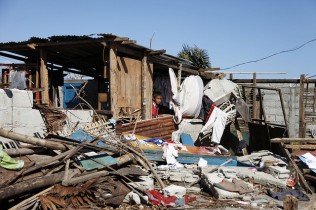
Typhoon Haiyan, or Yolanda as the locals call it in the Philippines, is the worst storm to hit the island nation in recorded history. The latest official death toll is at over 5,600, with more than 1,700 additional people missing and 3.5 million displaced. The worst-hit area, Tacloban City in Leyte Province in the Eastern Visayas region of the archipelago, is struggling to recover and rebuild with international aid and local governmental assistance.
Although many individuals feel compelled to help on the ground, the infrastructure in Tacloban and surrounding areas is rough at best, and some volunteer organizations fear that an onslaught of well-meaning individuals without specialized skills may do more harm than good. At a time when some areas may still not be secure enough or even have infrastructure set up for groups of people to arrive, it’s best for those with the skills and desire to help to go through an organized group that know exactly how qualified volunteers can help.
Young Pioneer Tours, a China-based tour operator that usually operates budget trips to North Korea, is one group that is organizing volunteers to help with the recovery efforts. The company’s travel director, Chris White, told the International Business Times (IBT) that people with specialized skills such as EMTs, medical professionals and construction workers are welcome to apply to become volunteers as long as they pay their own way. Young Pioneer Tours is also running an online fundraising campaign with a goal of raising $50,000 for medical supplies, tools, equipment and food.
“The worst thing someone could do is show up and add to the problem by not being prepared and getting into a situation they will need help getting out of,” White said in the IBT article. “Going with a group is the only way I suggest volunteering in this type of disaster.”
Another organization, Projects Abroad, is focusing on helping to rebuild schools and child care centers on northern Cebu Island. “We are helping to repair and renovate schools and child care centers so children can continue to receive regular education. We are also helping to look after children to allow families to focus on getting their lives back together and helping with relief efforts themselves,” Program Advisor Christian Clark said in the ITB article. Although volunteers are required to commit to two weeks and must pay their own way, Projects Abroad provides housing with host families whose homes were not damaged.
For those who lack the skills, resources or desire to volunteer, another important way to provide direct help to the Philippines is to vacation in one of the many beautiful and unaffected areas in the region, including the white sandy beaches of Boracay or the naturally formed chocolate hills of Bohol.
“There are more than 7,000 islands in the Philippines and a lot of them rely on tourism. It’s hard for people to picture the distance between islands and how the damage was concentrated in certain areas,” Susie Erbe, marketing manager for Worldwide Dive and Sail, which operates trips throughout the Phillippines, told The Guardian.
Richard de Villa of the department of tourism at the Philippines embassy in London said in the Guardian article that tourism accounts for eight percent of the country’s GDP and 2.9 million jobs, almost eight percent of the total employment. “If you stop tourism it will have a more negative impact on the local communities because of the role in our overall economy,” de Villa said
Since the typhoon, resorts at top destinations such as Boracay, Palawan, Cebu and Bohol have experienced cancellation rates as high as 30 to 40 percent, Cesar Cruz, president of the Philippine Tour Operators Association in Manila, told The Telegraph, despite the fact that only six of the 7,107 islands that make up the archipelago were affected by the typhoon.
On a positive note, however, travel agents based in Sydney and Melbourne, Australia, say people who had already booked travel to the Philippines for the upcoming weeks have not changed their plans, according to an article in the Herald Sun. Because travlers from Australia are the fifth-largest source of tourists to the Philippines with approximately 131,000 visits between January and August of this year alone, the Philippines tourism department has made a point of communicating to Australians that it is still safe to travel to the major tourist attractions, noting that “[t]ourism establishments and tourism activities continue and remain in operation in other parts of the Philippines, which play host to some of the country’s key tourist destinations.”
As always, donations are another good way to help. Organizations such as the United Nations World Food Programme, the Philippine Red Cross and Doctors Without Borders, to name just a few, will gladly take donations of any amount to help their efforts in Tacloban City and other devastated areas.
Read Ethical Traveler's Reprint Policy.
